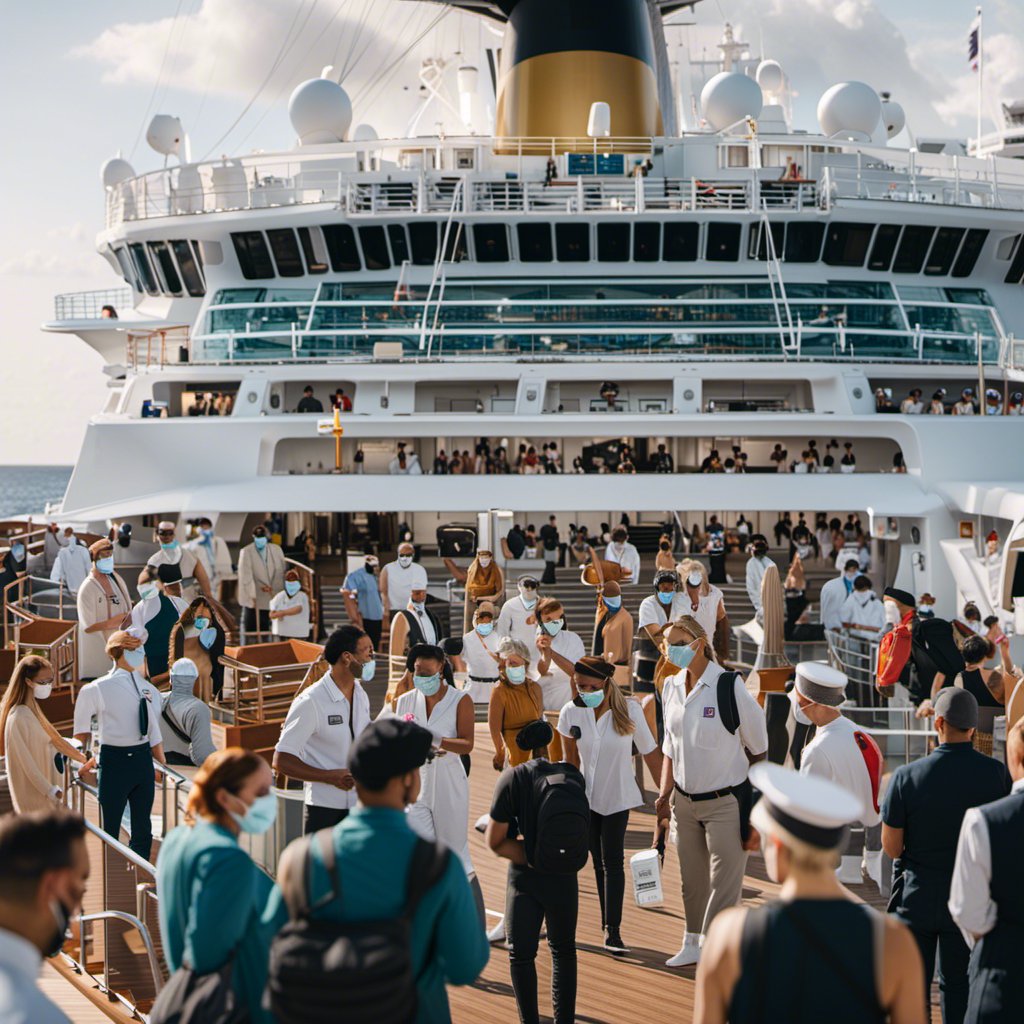As I begin my exploration into the world of COVID safety protocols for cruise lines, I find myself traversing a tumultuous sea filled with obstacles and crucial modifications.
Recent breakthrough cases among vaccinated passengers have rocked the industry, forcing cruise lines to reevaluate their strategies. Despite rigorous vaccination and testing requirements, the virus has managed to find its way through the cracks.
In this article, we will delve into the effectiveness of these protocols, the public relations hurdles faced by cruise lines, and the pressing need for increased testing measures.
Join me as we navigate the waters of safety and public image in the world of cruising.
Key Takeaways
- Breakthrough cases among vaccinated passengers pose a challenge for cruise lines.
- Increased testing may lead to more virus cases being tied to cruise ships, creating a public relations challenge.
- Cruise lines must balance safety measures with maintaining a positive public image.
- Cruise lines will continue to adapt and adjust their safety measures based on evolving circumstances.
Breakthrough Cases Among Vaccinated Passengers
As a cruise line passenger, I am concerned about the presence of breakthrough cases among vaccinated individuals. While the protocols and vaccine requirements implemented by cruise lines have been effective in reducing the spread of the virus, the recent cases of vaccinated passengers testing positive for COVID-19 have raised questions about their impact on public confidence and implications for herd immunity.
These breakthrough cases highlight the challenges faced by cruise lines in ensuring the safety of their passengers. The emergence of the highly transmissible Delta variant has further complicated the situation, leading to a surge in COVID-19 cases. Cruise lines will need to adapt and adjust their safety measures to address these challenges and maintain public trust.
Increased testing and continued vigilance will be essential in mitigating the spread of the virus and protecting both passengers and crew members.
Vaccination and Testing Requirements
I must highlight the importance of vaccination and testing requirements for cruise passengers. These measures are crucial in ensuring the safety and well-being of everyone on board.
As we navigate through the challenges of the ongoing pandemic, it is essential to explore alternatives and implement mandatory documentation to mitigate the risk of COVID-19 transmission. Here are three key points to consider:
-
Vaccination: Requiring all passengers 16 and over to be vaccinated helps reduce the potential spread of the virus and provides an added layer of protection. Children under 16 may sail unvaccinated but undergo testing before boarding.
-
Testing: Testing all passengers, regardless of vaccination status, before boarding ships departing from the United States on trips of five nights or more is necessary to detect any potential cases and prevent further spread.
-
Adaptation: Cruise lines must continually adapt their safety measures based on evolving circumstances, such as the emergence of breakthrough cases among vaccinated passengers and the increase in Delta variant cases. Exploring alternative protocols and adjusting testing requirements across all ships will be crucial for ensuring passenger safety in the future.
Effectiveness of Protocols and Vaccine Requirements
The effectiveness of vaccination and testing requirements on cruise ships is evident in their ability to identify cases, perform contact tracing, and isolate positive individuals.
These protocols play a crucial role in maintaining passenger confidence and ensuring the safety of everyone on board. By implementing strict requirements for vaccination and testing, cruise lines can quickly identify any positive cases and take immediate action to prevent the spread of COVID-19.
This includes conducting thorough contact tracing to identify potential exposure and isolating positive individuals to minimize the risk of transmission. The effectiveness of contact tracing on cruise ships is particularly important due to the close proximity of passengers and crew members.
Public Relations Challenges
Navigating the public relations landscape amidst the increased testing and breakthrough cases has become a delicate balancing act for cruise companies. Balancing public perception and managing media scrutiny is crucial in maintaining a positive image.
The emergence of breakthrough cases among vaccinated passengers poses a challenge for cruise lines, as it may lead to more virus cases being tied to their ships. Unlike other travel industries, cruise lines have stricter requirements, including proof of vaccination and testing. Close contact in cruising increases the risk of virus spread, and the CDC acknowledges that cruising is not a zero-risk activity during the pandemic.
To address these challenges, cruise lines must continue to adapt and adjust their safety measures based on evolving circumstances. It is essential for them to prioritize passenger safety while effectively communicating their efforts to the public, ensuring transparency and building trust.
Increased Testing Measures
Implementing increased testing measures across all ships is crucial to ensure passenger safety amidst the emergence of breakthrough cases among vaccinated passengers. As the Delta variant continues to impact communities, cruise lines must adapt their COVID testing requirements to mitigate the risk of transmission on board. To emphasize the importance of this measure:
- Regular testing can help identify asymptomatic cases and prevent further spread.
- Testing all passengers, regardless of vaccination status, provides an additional layer of protection.
- The Delta variant’s higher transmissibility underscores the need for comprehensive testing protocols.
- Implementing these measures proactively demonstrates the cruise industry’s commitment to passenger safety.
- Increased testing can help regain public trust and confidence in cruise travel.
Balancing Safety Measures and Public Image
In the previous subtopic, we discussed the increased testing measures implemented by cruise lines to ensure passenger safety. Now, let’s delve into the current subtopic of balancing safety measures and public image.
Cruise lines face a unique challenge in maintaining a positive public perception while prioritizing risk management. On one hand, they must implement stringent safety protocols to prevent the spread of COVID-19 and protect their passengers and crew. On the other hand, they need to strike a balance that doesn’t deter potential customers or damage their reputation.
To address this challenge, cruise lines have been proactive in adapting their safety measures. They have implemented vaccination requirements, testing protocols, and strict health and safety guidelines. These measures not only aim to reduce the risk of virus transmission but also provide reassurance to passengers.
In order to convey the importance of these safety measures, cruise lines can use effective public relations strategies. Clear communication about their protocols, transparency in reporting any cases, and showcasing their commitment to passenger safety can help improve public perception and maintain trust.
Furthermore, cruise lines must continually evaluate and adjust their safety protocols based on evolving circumstances and expert guidance. This proactive approach demonstrates their commitment to risk management and reinforces their dedication to passenger well-being.
Overall, by effectively balancing safety measures and public image, cruise lines can navigate the challenges posed by the pandemic and instill confidence in their customers.
Future Considerations for Cruise Lines
Going forward, I will carefully evaluate the evolving circumstances and expert guidance to ensure the well-being of passengers and adapt our measures accordingly.
In light of the recent breakthrough cases among vaccinated cruise passengers, it is crucial for cruise lines to implement enhanced testing protocols. This will help identify any potential cases of COVID-19 and prevent the spread of the virus onboard.
Additionally, addressing vaccine hesitancy is of utmost importance. Cruise lines can play a significant role in promoting the benefits and safety of vaccination to instill confidence in passengers.
By working closely with health authorities and following their recommendations, we can continue to refine our protocols and keep passengers safe.
It is our responsibility to stay proactive and vigilant in order to navigate these challenges and ensure a safe and enjoyable cruising experience for all.
Adapting Safety Protocols in Response to Evolving Circumstances
As the situation evolves, I will closely monitor expert guidance and make necessary adjustments to ensure the continued well-being of passengers. Adapting safety protocols in response to evolving circumstances is crucial in the ever-changing landscape of the COVID-19 pandemic.
To address the changing protocols, I will consider the following:
-
Enhancing testing measures:
- Implementing increased testing across all ships to ensure passenger safety.
- Conducting pre-boarding testing for all passengers, regardless of vaccination status.
-
Strengthening vaccination requirements:
- Requiring all eligible passengers to be fully vaccinated before boarding.
- Ensuring that children under 16 undergo testing and other safety measures.
-
Implementing stricter safety measures:
- Enhancing contact tracing efforts to identify potential cases.
- Isolating and providing necessary care for positive cases.
Frequently Asked Questions
How Many Passengers on Royal Caribbean’s Adventure of the Seas Tested Positive for Covid-19?
Six passengers on Royal Caribbean’s Adventure of the Seas tested positive for COVID-19. Four were fully vaccinated, two were unvaccinated. Cruise lines’ response to breakthrough cases will impact future bookings and may require increased testing protocols.
What Were the Vaccination and Testing Requirements for Cruise Passengers on Royal Caribbean?
Royal Caribbean required all passengers 16 and over to be vaccinated and tested before the cruise. Children under 16 were allowed to sail unvaccinated but underwent testing before boarding.
How Many Cruise Ships Sailing or Planning to Sail From the United States Have Yellow or Orange Status Indicating Possible COVID Cases in the Past Week?
As of now, there are 30% of cruise ships sailing or planning to sail from the United States with yellow or orange status, indicating possible COVID cases in the past week. This poses challenges in contact tracing and adaptations in quarantine protocols.
What Are the Public Relations Challenges Faced by Cruise Lines in Implementing COVID Safety Protocols?
Public perception and crisis communication are major challenges for cruise lines implementing COVID safety protocols. Stricter requirements, increased testing, and the potential for virus cases create a delicate balance between passenger safety and maintaining a positive public image.
How Has the Emergence of Breakthrough Cases Among Vaccinated Passengers Affected Cruise Lines’ Safety Measures and Protocols?
The emergence of breakthrough cases among vaccinated passengers has prompted cruise lines to reassess their safety measures and protocols. It has impacted customer confidence, but the effectiveness of vaccines and strict protocols continue to be prioritized.
Meet Asra, a talented and adventurous writer who infuses her passion for exploration into every word she writes. Asra’s love for storytelling and her insatiable curiosity about the world make her an invaluable asset to the Voyager Info team.
From a young age, Asra was drawn to the power of words and their ability to transport readers to far-off lands and magical realms. Her fascination with travel and cultures from around the globe fueled her desire to become a travel writer, and she set out on a journey to turn her dreams into reality.











